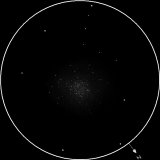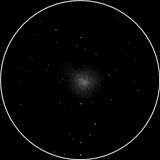
| MESSIER 22 |
|---|
RA: |
18h 36m 24s |
|
DEC: |
-23° 54' 00'' |
|
Type: |
Globular cluster |
|
NGC: |
6656 |
|
Magnitude: |
5.10 |
|
Surface brightness : |
11.7 |
|
Apparent dimensions : |
24'x24' |
|
Distance: |
10,400 ly |
|
Messier 22 (also known as M22 or NGC 6656) is an elliptical globular cluster in the constellation Sagittarius near the Galactic bulge region. It is one of the brightest globulars that is visible in the night sky. M22 was one of the first globulars to be discovered in 1665 by Abraham Ihle and it was included in Charles Messier's catalog of comet-like objects in 1764. M22 is one of the nearer globular clusters to Earth at a distance of about 10,600 light-years away. It spans 32' on the sky which translates to a spatial diameter of 99 ± 9 light-years. 32 variable stars have been recorded in M22. It is projected in front of the galactic bulge and is therefore useful for its microlensing effect on the background stars in the bulge. Despite its relative proximity to us, this metal-poor cluster's light is limited by dust extinction. M22 is unique in that it is one of only four globulars (the others being M15, NGC 6441 and Palomar 6) that are known to contain a planetary nebula (PN). It was discovered using the IRAS satellite by Fred Gillett in 1986 as a pointlike source and subsequently identified as a PN in 1989 by Gillett. The PN's central star is a blue star. The age of the PN is estimated to be a mere ~6,000 years old. |
||
Other sketches |
|||||
 |
|||||
Messier 22 (July 06). |
|||||
VEDRAN VRHOVAC© 2006.-2007. |
